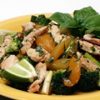New government research shows that tomatoes should not be considered our only major source of lycopene, the phytochemical (natural plant substance) that could help prevent certain cancers and other health problems. Watermelon may be just as good a source.
Lycopene is the substance that gives tomatoes, watermelon, guava, and red and pink grapefruit their characteristic color. Besides adding color, lycopene seems to be a powerful antioxidant. It neutralizes highly unstable molecules that would otherwise react with and damage our cells.
In a large Harvard University study, the risk of prostate cancer was a third lower in men who ate the most tomato products compared to men who ate the least, and many researchers believe lycopene was the reason. Later studies also linked greater consumption of foods high in lycopene with a lower risk of prostate and other cancers.
According to a new report published in Agricultural Research, the U.S. Department of Agriculture's Agricultural Research Service (ARS) tested 13 varieties of watermelon for lycopene content and found that watermelon contains more than tomatoes do.
The amount of lycopene varied among varieties (red seedless have most) as well as growing conditions. Of course, processed tomato products like sauce and juice contain a large concentration of tomatoes in a small portion, so a standard serving of these products contains more lycopene than in a typical one-cup serving of watermelon.
Past research with lycopene from tomatoes has shown that this phytochemical is not absorbed equally well from all foods that contain it.
Studies show that the lycopene in tomato products that have been heat-processed (like tomato juice and sauce) is better absorbed than that in raw tomatoes. Yet in comparisons made after three weeks of consuming equal amounts of lycopene from heat-processed tomato juice and unprocessed watermelon juice, ARS research found similar blood levels of the antioxidant.
Researchers next plan to evaluate whether lycopene from watermelon is, like that from tomatoes, better absorbed when consumed in a meal containing some fat.
Even without these new findings about lycopene, watermelon has always been an excellent choice for snacks, desserts and salads.
Each cup (about half a large slice) offers about 14 milligrams of vitamin C (16 to 19 percent of recommended daily intake). Watermelon also offers a weight-control bonus. A one-cup serving can satisfy a sweet tooth with just 49 calories, making it one of the fruits least concentrated in sugar and calories.
Nevertheless, we need to remember that lycopene is still just one small element in the overall picture of how eating substantial amounts of fruits and vegetables helps protect our health.
The American Institute for Cancer Research estimates that meeting the recommendation of at least five servings of fruits and vegetables daily could reduce cancer incidence by as much as 20 percent.
By eating a wide variety of produce, we can ensure that we will also get a wide range of the phytochemicals unique to certain types of fruits and vegetables.
Dark leafy greens, berries, citrus fruit, and different types or families of vegetables all offer their own particular phytochemicals.
If we go beyond improving the balance of fruits and vegetables in our diets to meet other AICR recommendations as well, like limiting saturated fat and alcohol, maintaining a healthy weight and staying physically active, our cancer incidence could drop 30 to 40 percent.
0
AICR







